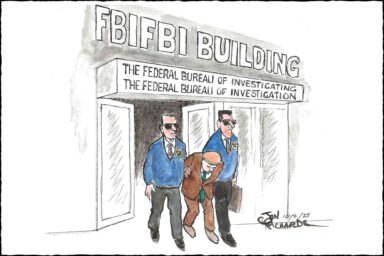Roger Shuler spent the last few months staring at cell bars. Now, he’s out. But the question is—why was a blogger who took on a scion of Alabama’s Republican party placed in jail in the first place?

An Alabama blogger posted a simple question on his website this week: “Why did it take five months for me to be released from jail?”
Roger Shuler’s extraordinary imprisonment last autumn came after he blogged about allegations of an affair between a powerful Republican and a lobbyist, and in conservative Alabama, it seems that can land you some enemies.
WhoWhatWhy has been on the case from the beginning and also obtained an exclusive interview with Shuler behind bars. “Free press, free speech, the First Amendment—none of this means anything to these people,” Shuler told us in that interview.
Shuler found himself behind cell bars after refusing what he called a judge’s “unlawful” order to scrub his blog, “Legal Schnauzer,” of the scandalous stories. Those stories alleged an affair between a scion of one of Alabama’s elite Republican families, Robert Riley, Jr., and Liberty Duke, a registered lobbyist. Both have denied the affair and accused Shuler of defamation.

But in fact, the judge has not ruled on the defamation claim—meaning that Shuler was found in contempt even though no defamation had been determined. “Unconstitutional prior restraint,” the Reporters Committee for Freedom of the Press called it.
But the scent of southern politics surrounded the case. The judge who placed Shuler in jail happened to have been appointed by the state’s Chief Justice, Roy Moore. As WhoWhatWhy reported, Moore is a controversial Republican, and a key player in Karl Rove’s GOP effort to draft conservatives to the bench.
There have been consistent protests about Shuler’s incarceration. The Reporters Committee for Freedom of the Press cited Shuler as the only journalist in the western hemisphere to be jailed like this. The American Civil Liberties Union protested, too. Even The New York Times finally caught on to the case, covering Shuler’s story months later, in January.
Particularly galling to Shuler is that he could not have extricated himself from the contempt charges even if he’d wanted. Because he was behind bars, he says he had no way to remove the posts. Writing on his blog this week he said, “In jail, with no access to a computer or the Web, I was not physically capable of complying with the court’s order.”

So what led to his release? Judge Claud Neilson wrote that Shuler’s wife, Carol, “removed most of the subject matter of the injunction from the ‘Legal Schnauzer’ blog, from Shuler’s YouTube account, and from Shuler’s Twitter account.” He warned, however, that Shuler is under a permanent injunction and cannot post the comments again.
Responding to Birmingham News reporter, Kent Faulk, Shuler called it “not the desired outcome.” He told Think Progress he is planning a civil lawsuit over his detention.
Shuler’s question, “Why did it take five months for me to be released from jail?” is a fair one. But the real questions have broader ramifications:
In 2014, what does all this say about the health of the First Amendment? And just as important—why did it take mainstream news organizations such as The New York Times so many months to realize what was at stake?
[box] WhoWhatWhy plans to continue doing this kind of groundbreaking original reporting. You can count on us. Can we count on you? What we do is only possible with your support.
Please click here to donate; it’s tax deductible. And it packs a punch.[/box]


